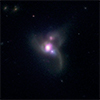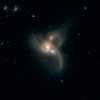CXC Home | Search | Help | Image Use Policy | Latest Images | Privacy | Accessibility | Glossary | Q&A
X-ray and Optical Images of Merging Supermassive Black Holes
(Credit: TBD)
(Credit: TBD)
These four objects come from a study of seven triple galaxy mergers. By using Chandra and other telescopes, astronomers determined what happened to the supermassive black holes at the centers of the galaxies after the collision of three galaxies. The results show a range of outcomes: a single growing supermassive black hole, four doubles, a triple, and one system where no black holes are rapidly pulling in matter. Two of the doubles are shown here in X-rays from Chandra and optical light from SDSS and Hubble (J1027 & J1708), as well as one triple (J0849), and one single (NGC 3341). This information tells astronomers more about how galaxies and the giant black holes in their centers grow over cosmic time.
Return to: Galaxies Hit Single, Doubles, and a Triple (Growing Black Holes) (January 14, 2021)
















